Every time a customer lands on our product page, we want them to buy our product. If not all visitors, then the majority of them. The process of achieving this goal can be simplified into two manageable steps.
- Making it easy for them to get what they want.
- Inform them how to get what they want.
If you can deliver on these two points, you can optimize your e-commerce product page for maximum conversion.
We are sharing 15 practical tips to optimize e-commerce product pages, specifically to increase your customer base. More importantly, our goal is to help you understand why.
Why do customers prefer brands when they follow these optimization tips?
Once you have that insight, optimizing product pages will no longer be a huddle. Let's solve the mysteries step-by-step.
15 Tips to Optimize E-Commerce Product Pages
1. Use high-quality product images
Most of our buying decisions are visually driven. 90% of internet consumers cited the quality of product images as the most important element when buying online.
When customers land on a product page, they want to see:
- What are they buying?
- How does the product look?
- What information can they get from the images?
If you are unable to hold their interest at the initial stage, it’s difficult to convince them to buy anything.
-
Use large images
To make it easy for customers, e-commerce can opt to use larger and high-quality product images on their page.
According to Slazzer, increasing the image size alone can increase your sales by 9.46%. Using large images instantly grabs customers' attention and makes it easy for them to engage with the product.
Moreover, the zoom capability (best used with high-quality images) allows customers to focus on the details of the product.
If we look at the product page of Nike today, they too have increased the size of their image compared to a few years ago.
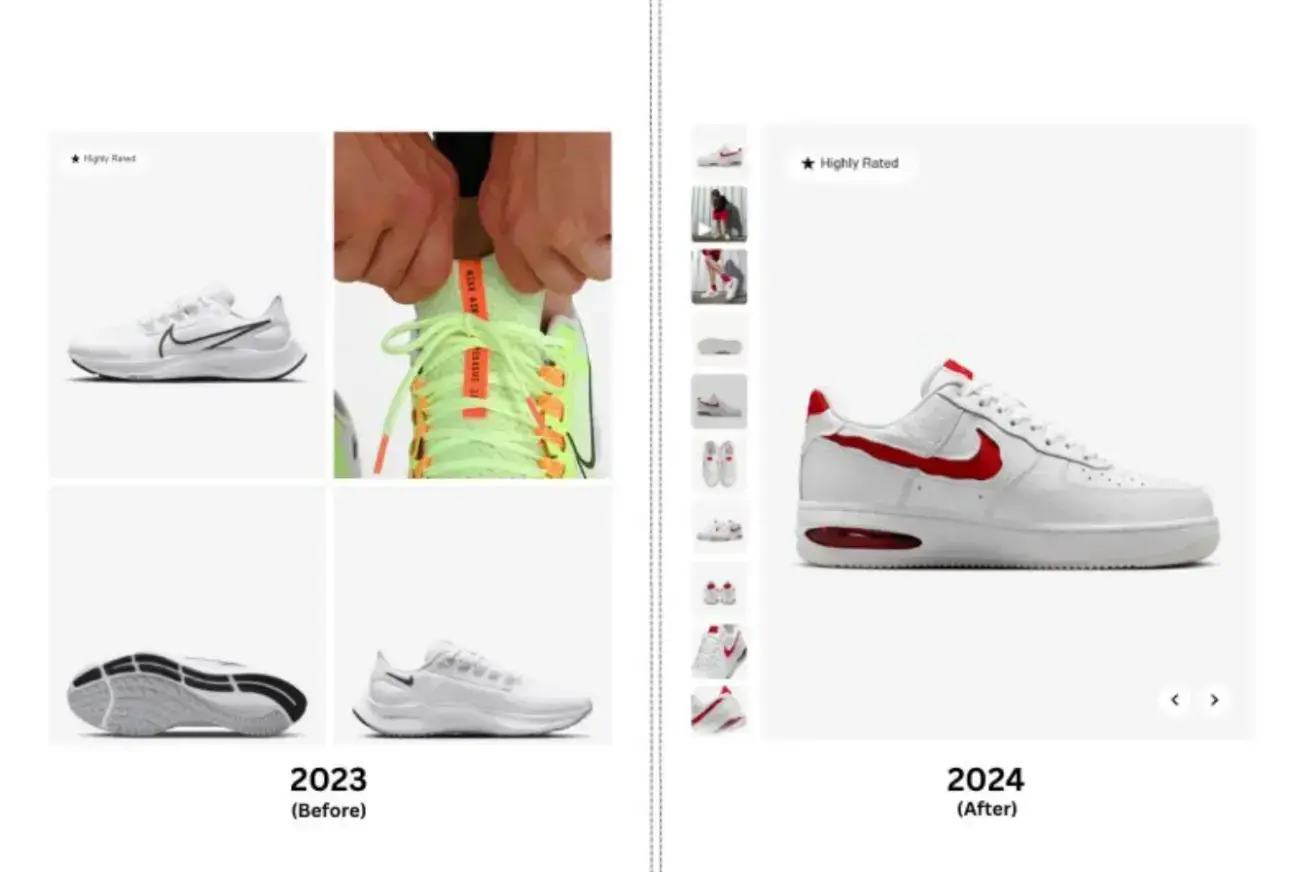
In 2023, the brand featured four product images above the fold. In 2024, Nike featured only one large image while showcasing other images in the gallery on the left.
-
Showcase products from multiple sides
During the sprints of e-commerce product page optimization, focus on the number of images you want for your products.
The goal is not to fill the gallery but to inform the shopper of how the product looks from all sides.
Most grocery and day-to-day products might not need more than 3 to 4 images. The product and packaging are pretty standard here.
Moreover, the information they seek regarding ingredients is best suited for description and infographics. Fashion and furniture products, on the other hand, might require 8 to 10 images. These are the products where customer decisions are highly driven by visuals.
If they don’t like how it looks, they might not be interested in what it is made of.
-
Highlight details in photos
For products that boast high-quality craftsmanship, showcasing these details in photos is not just valuable; it's reassuring. It grows confidence in your audience about the quality of your product, which is crucial in e-commerce product page optimization.
If there's a unique side of the product or a detail that's important, make sure to feature it specifically. Even if we look at the makeup brands, for example Beauty Bae, they showcase the texture of the makeup separately.

Source: BEAUTY BAY
It is a common practice in the industry that ensures customers learn about the feel of the product.
Similarly, if we look at Montblanc’s luxury product photography, they ensure to showcase the details using high quality product images.

Source: MONTBLANC
Showcasing details also brews trust. Customers can confidently make buying decisions since they know the product well.
-
Stay consistent with presentation
Consistent in terms of product photography, photo retouching, and overall presentation.
During e-commerce product page optimization, understand that customers will browse through different products to choose the best one for them.
As an e-commerce, you have to make it easy for them to look at different products and make their decision.
Ensuring the products look clean and have a cohesive presentation is the first step towards building trust.
It is recommended to use a light color background that is consistent across your product images. This, along with consistent product photography angles.
Doing so will make it easy for customers to focus on the product and not be distracted from other elements. To do so, you can even use professional product photo editing services like PixelPhant.
These are services that allow you create high-quality and consistent product presentation by editing product images as per your specific requirements and style guide.
2. Showcase product variation
If a product on your e-commerce product page has multiple variants, make sure to showcase them early on. Also, have a dedicated page for each variation, linked with one another.
You’ll often find brands showcasing these variants right below the title.
These variations can be different color options, prints, size, type, deal, fabric etc. Allbirds use color tones and showcase them in classics and limited editions.
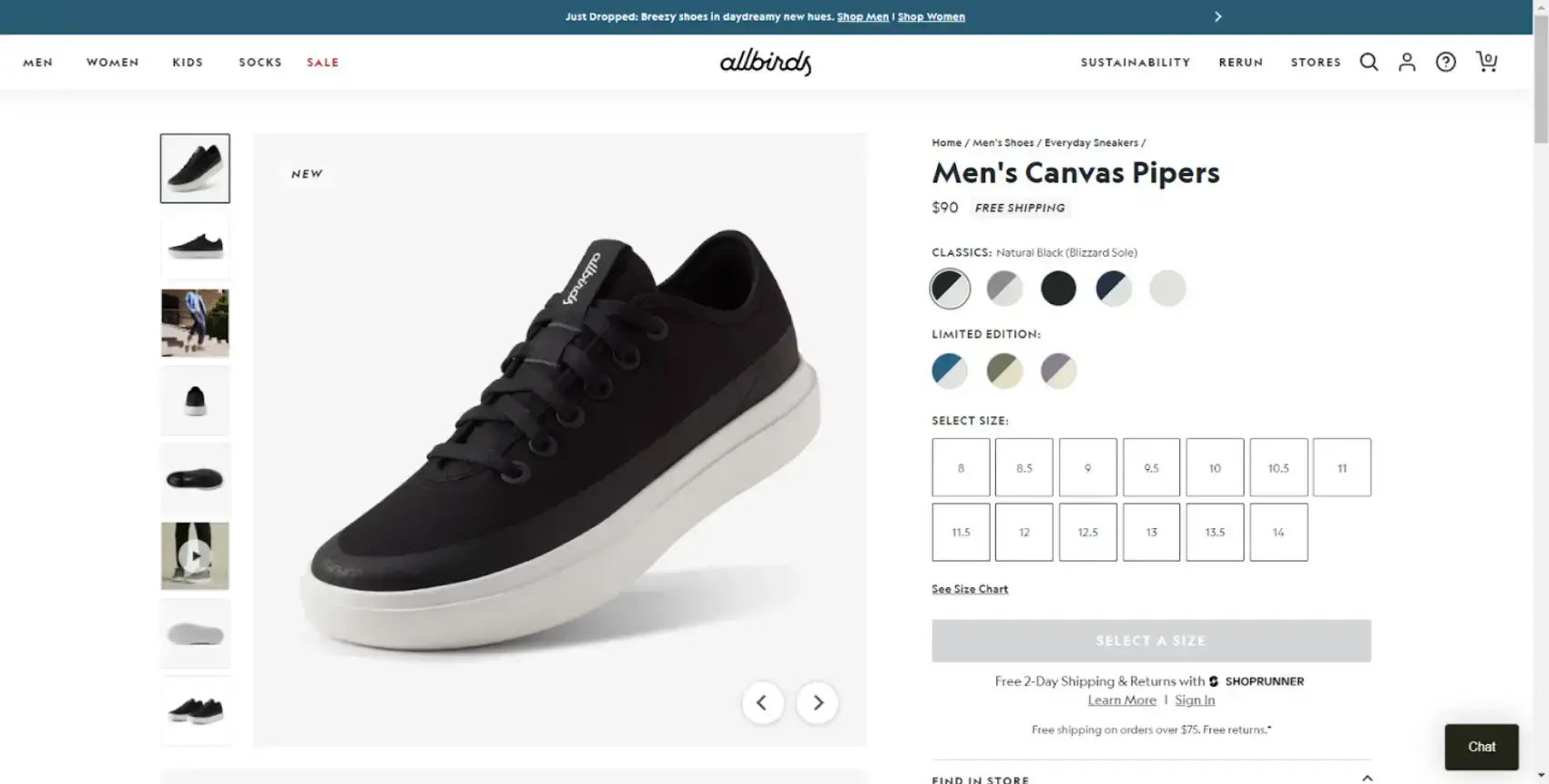
Source: allbirds
For example, an ecommerce grocery platform like wavegrocery.com ensures customers can easily browse product variations, such as different package sizes or organic alternatives, directly on the product page, enhancing the shopping experience.
For customers, it becomes easy to go through all their options at a glance and find their favorite product quickly.
To do so in an aesthetic manner, brands use product swatches as well. That means, instead of showcasing a tiny thumbnail, they only feature a sample of color and print.
Showcasing product variation allows customers to choose the best pick for them. But it can also increase the customer's cart value.
If a customer wants the same product in different variations, they know where to find it right away.
3. Use a clear CTA
If you are creating a call to action to optimize your e-commerce product page, aim for clarity over creativity.
Call-to-action persuades people by telling them what to do and what will happen at the same time.
For example, the Add To Cart button motivates your customers to add the product in their cart. At the same time, it informs them that if they want to add this product in cart, they have to click right here (on the button).
If you are trying to add a creative CTA on your e-commerce product page, ensure that the message is clear. Avoid specific slang or jargon. You don’t want customers to be distracted, especially at this crucial stage.
4. Have a “Wishlist” button
E-commerce puts a lot of effort into acquiring new visitors on-site. But sadly, 92% of them don't intend to make a purchase on the first visit.
Rather, they visit to research. They want to experience the brand and look at the products on the site. In this case, e-commerce can use this insight and create an "Add to wishlist" button on their e-commerce product page.
Having a wish list button is a good alternative for customers who like the product but don't intend to buy it right away.
According to a Google study, 44% of shoppers want a wish list where they can save the product they are interested in. This allows visitors to save their product by simply creating an account that will save all their wishlist products at one place.
E-commerce can then use the wishlist insight to identify what customers like, create personalized campaigns, and increase store sales.
This insight can be further used by the marketing team as well to create specific campaigns and run discounts to acquire new customers.
5. Ensure the title, description, and images are aligned
One of the most common mistakes that can be found on an e-commerce product page is inconsistency in product images, title, and description. The core reason behind this is the lack of content management.
When your customer lands on an e-commerce product page, they want to see, read, and learn about one product.
If your title, description, and product images are not aligned, it will create confusion and low sales. To avoid these unwanted losses, ensure that a content management system is installed.
You can use Google Sheets or dedicated software. This will allow you to keep track of every piece of content that is published on site all available at one place to go through.
6. Use detailed and clear description
When we want to learn more about the product, we head towards the product description.
Does that mean we want to go through a big block of text? Not at all.
Customers want to skim through the information while knowing everything that matters about the product. Reading a block of text requires effort.
E-commerce can eliminate most of it by using digital badges, graphics, and bullet points.
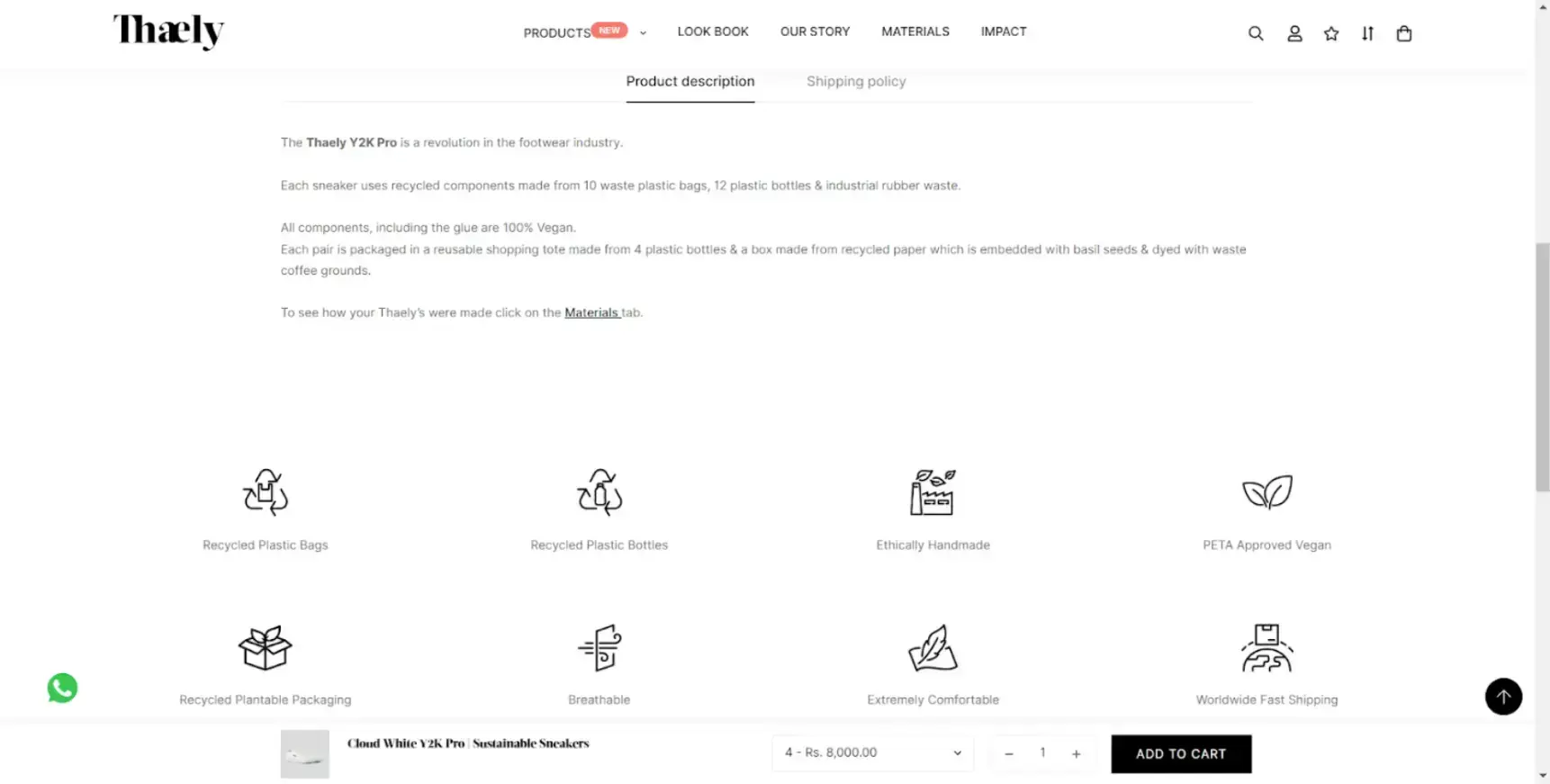
Source: Thaely
Thaely, a sustainable sneaker brand's description is easy to go through, thanks to the icons they use.
Similarly, instead of writing about certifications, brands can show a PETA-certified badge. The same goes for badges like 100% natural, baby safe, toxin-free, free shipping, etc.
Writing engaging product descriptions that sell can be challenging at first. However, if you focus on clarity of information, you can easily optimize your e-commerce product page description.
7. Use “back-in-stock” notifier
An e-commerce should never remove or hide a product page when it’s out of stock. Rather, use a back-in-stock notifier system to engage your customers.
According to Barilliance, back-in-stock emails have an open rate of almost 65.32%. And if we talk about conversion, back in stock email campaigns have shown close to 15% conversion rate.
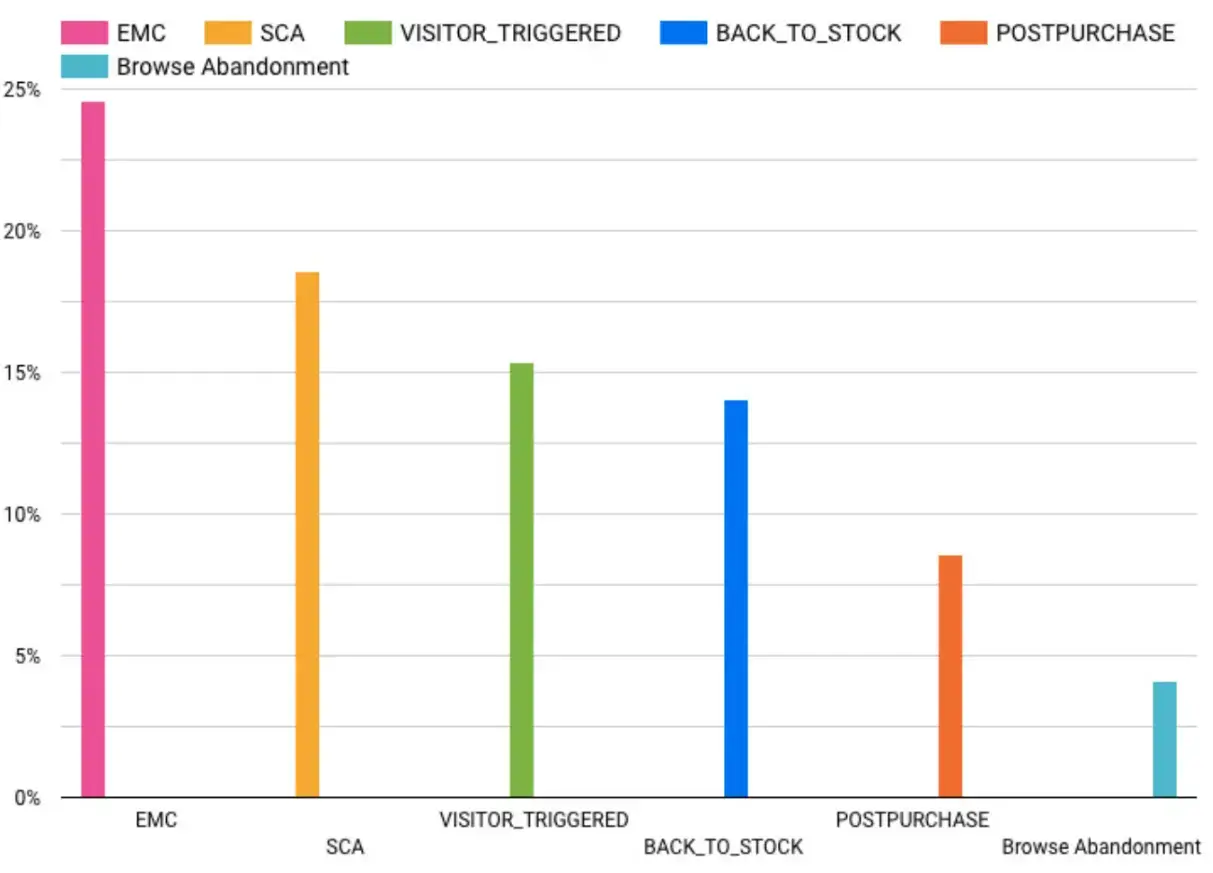
Source: Barilliance
When you remove a page, you lose your search engine position. This means losing a customer that might have discovered your brand and bought from you in the future.
Using a back in stock notifier system on your e-commerce product page, lets you capture the same leads that you can connect when the product is back in stock.
8. Keep stock meter updated
In e-commerce product page optimization, we have been talking and informing the customer. Telling them when the limited stock is left is important as well.
We know most customers aren’t looking to make a purchase. But letting them know they might not be able to buy the product again for a while can surely help them in making better decisions.
For example, if you have only 5 pairs of shoes left in the inventory—let your customer know. This way, if they are planning to buy the product in the next few weeks, they will know the chances of the store going out of stock are high.
The psychological effect of scarcity and FOMO also plays an important role in e-commerce conversion.
Scarcity, in terms of consumer psychology, refers to the notion where limited availability of product makes the product even more desirable. This contributes to impulse buying decisions, hence increasing e-commerce product page conversion when you are running low on stocks.
9. Use compelling lifestyle and use case images
When a customer buys a product, they are buying the lifestyle and use case of the product.
While this is true for everything we buy, in the case of luxury goods, these factors are much more prominent. On your e-commerce product page make sure to give a glimpse of this lifestyle and use case to your customer.
One of the easiest ways to do so is through your lifestyle images. These are product images that showcase the product in a relevant environment.
La Sportiva is an American shoe brand that sells climbing shoes. When we scroll down on their e-commerce product page, we see they feature shoe photography where their product is in action.

Source: La Sportiva
Similarly, if we look at the e-commerce product page of Lori Beds, we see the features of mattresses are explained alongside their lifestyle images.
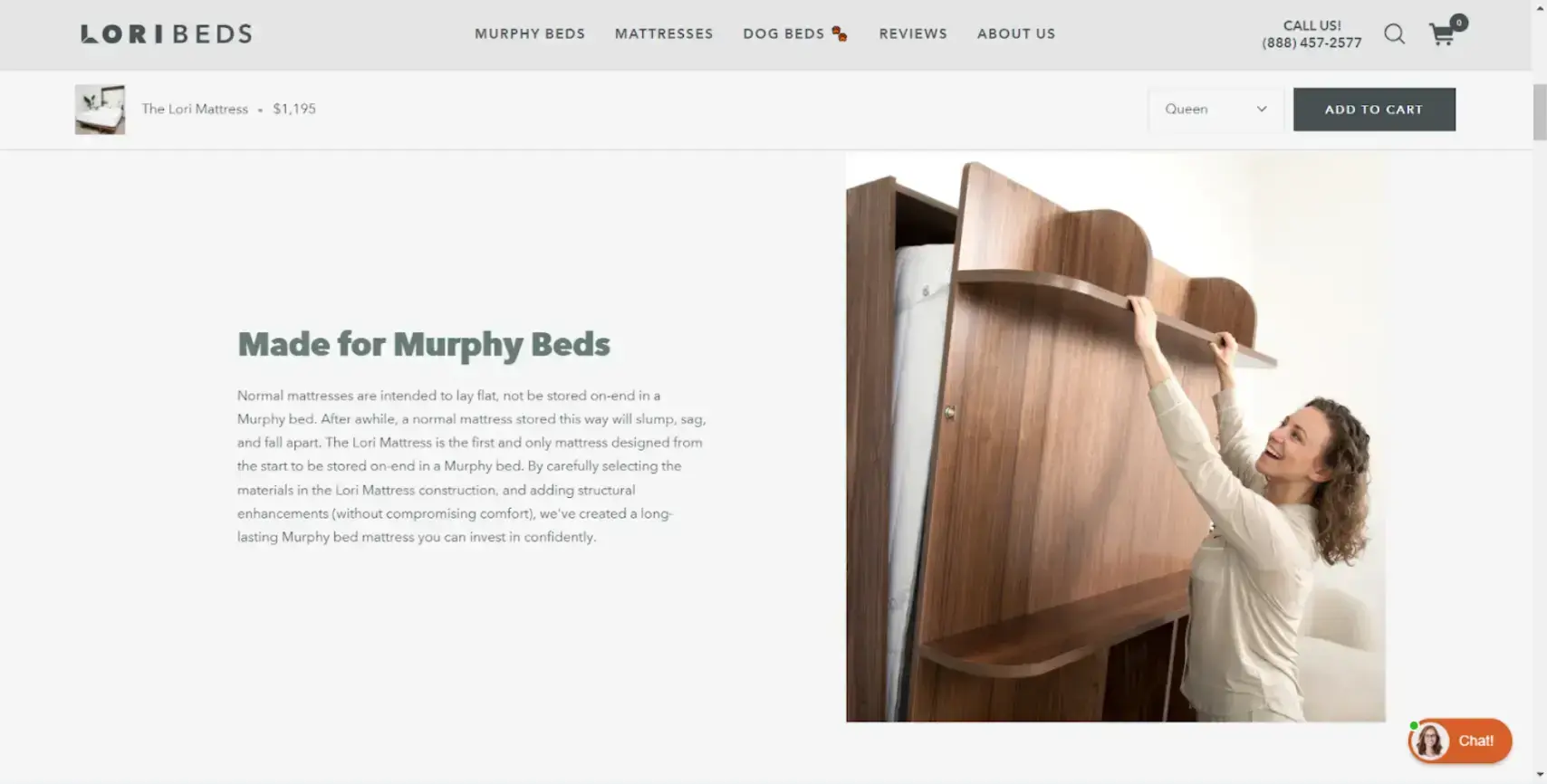
Source: LORIBEDS
Showcasing these use cases and lifestyles on your e-commerce product page can answer a customer on:
- Why is the product best suited for them?
- How can they use the product in different ways?
- How does the product look in a real-life environment?
10. Show thoughtful product recommendation
Product recommendation can be divided into two types:
- Product Upselling
- Product Cross-selling
Upselling means encouraging customers to buy a more premium product than what they are looking at.
For example, if you have a look at Away’s e-commerce product page, you will see that they allow personalization at $50 extra. This is a simple way to upsell.
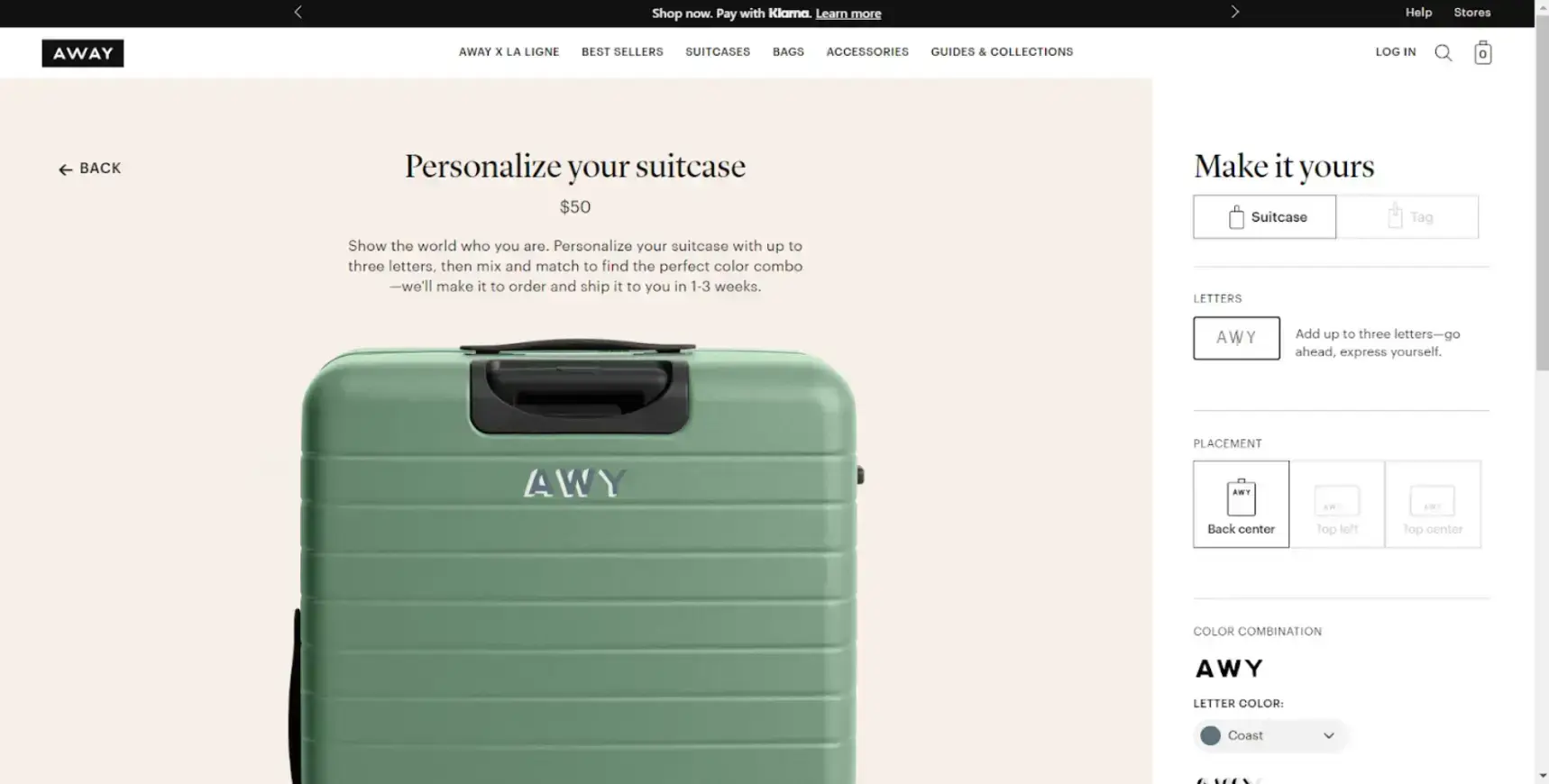
Source: AWAY
Cross-selling means suggesting related and complementary products along with what the customer is interested in buying.
For example, if we look at Gutteridge’s e-commerce product page, we will find them recommending products that will go well along with the Polo shirt you are interested in.
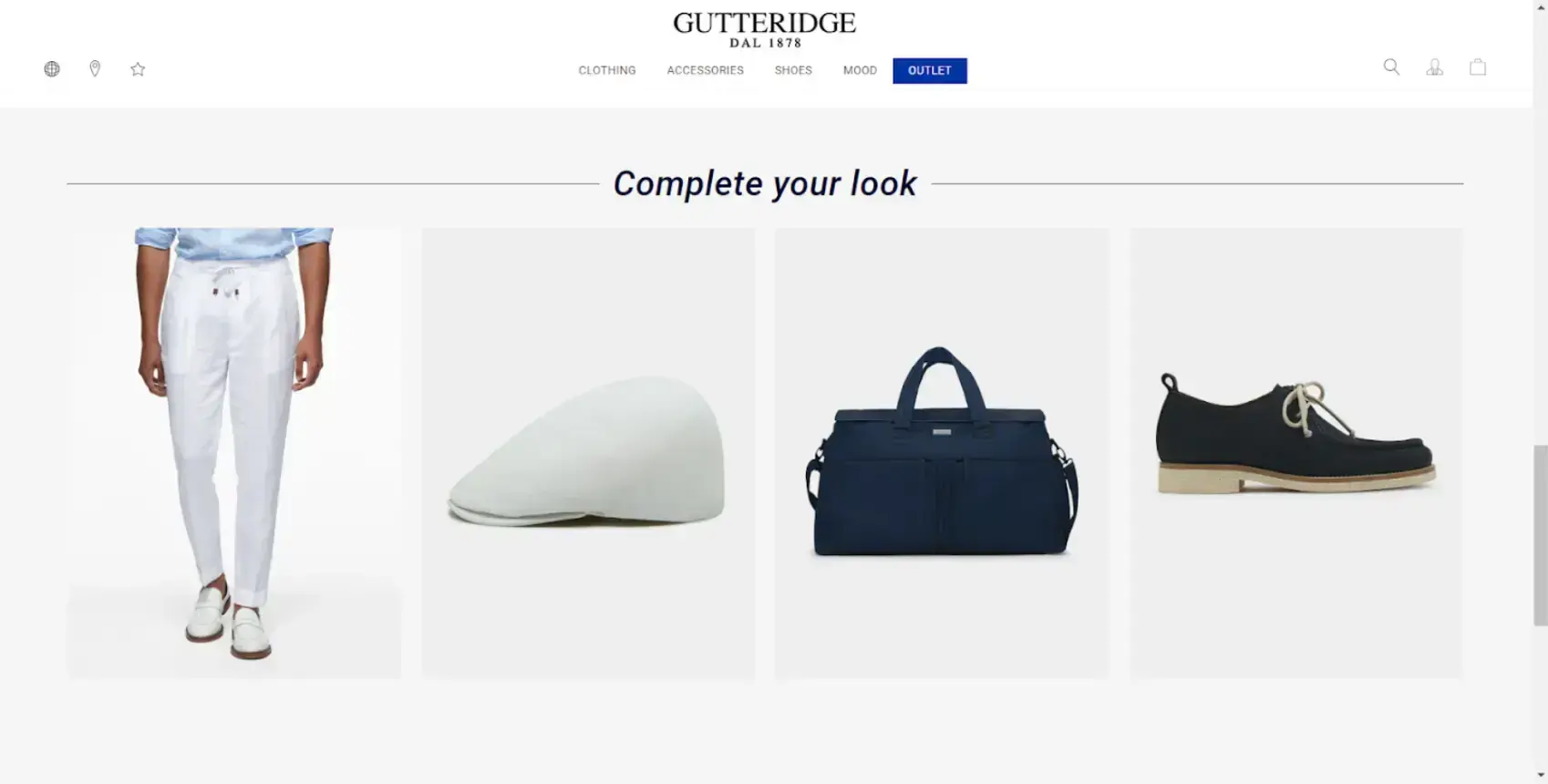
Source: GUTTERIDGE
Using upselling and cross-selling techniques in e-commerce product page optimization can effectively improve your sales.
Moreover, since you're assisting your customers, they might love your brand as well. Just make sure not to be pushy with these techniques.
11. Have easy size guide
Size guides are an essential element of e-commerce product page optimization. They play a vital role in helping customers make better decisions and, hence, help with products.
The size guide will be different for different types of product. For example, XL size in clothing and XL in mattress mean totally different.
But it is essential that you add relative information like cm, inches, and other units that help customers understand the size of the product in real life.
One such informative guide can be seen on Tiffany’s e-commerce product page.

Source: Tiffany & Co
They share common ring sizes in the US and compare them with the circumference of the ring in mm.
Additionally, if you scroll down, they will tell you how to measure the size of the ring for yourself. This shows that brands understand the customers and want to help them make the right decision.
12. Highlight category discount
When a customer lands on your e-commerce product page, they must be able to get as much information as possible.
Along with the product, they must also be able to learn about the deals you are offering. That is why, if you are running a category discount—make sure to feature it on your product page as well.
A discount such as Buy 1 Get 1 Free can be highly specific for a category. So make sure every product that is part of the deal promotes the deal as well.
Every deal that runs across your site must be featured on your e-commerce product page as well. Doing so will remove any confusion for the customer; hence, they will be able to process with confidence.
13. Ease navigation between pages
When a customer is able to navigate between various e-commerce product pages, they are able to focus on the product even more.
Just think about it. Would you be willing to go through each and every product category to find other options?
Tocrystal is a wholesale crystal supplier. However, since they have so many products and categories, navigating through them can be difficult.
The solution? Using breadcrumb on the e-commerce product page.

Source: tocrystal
Right above the title and product image, we can see the pyramid is in the Orgone Pyramid category, which is in Orgone category.
Using breadcrumb on your e-commerce product page allows customers to easily navigate through the site while being informed of where they are in the site hierarchy.

